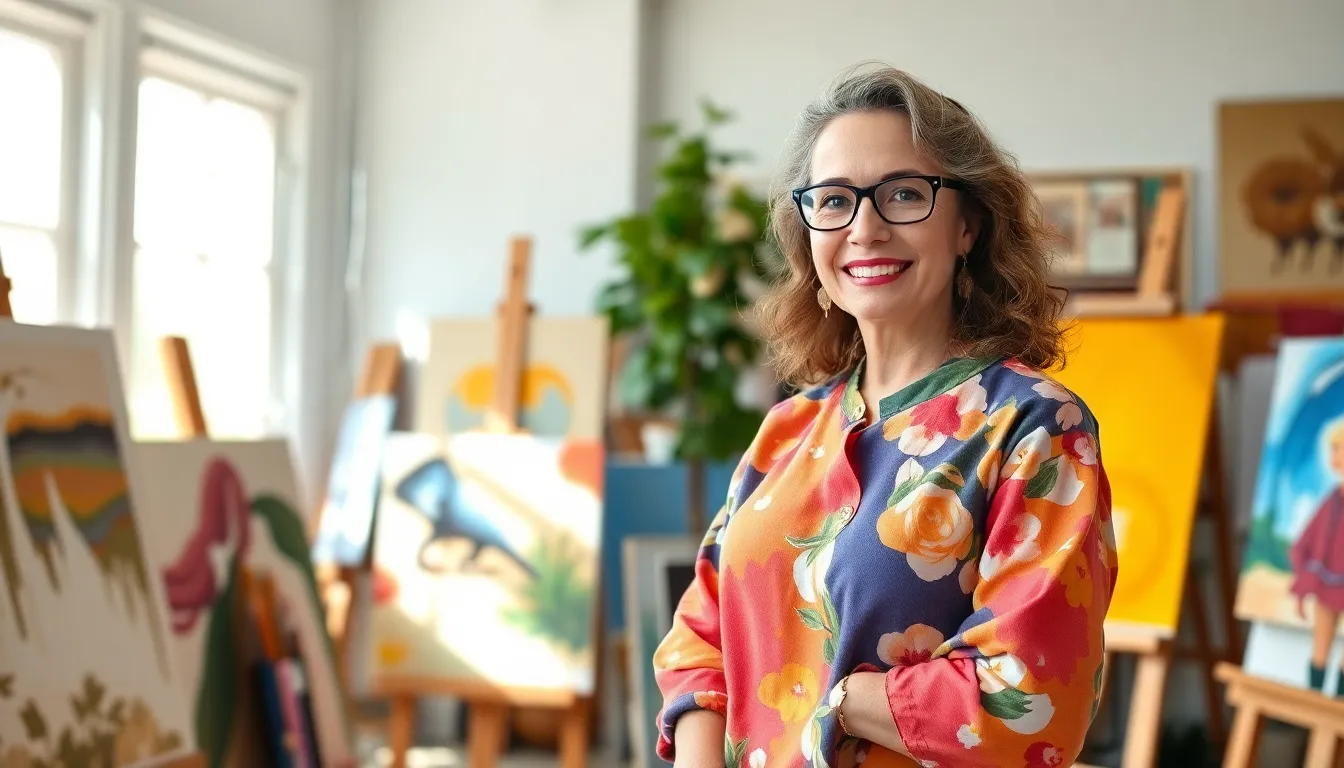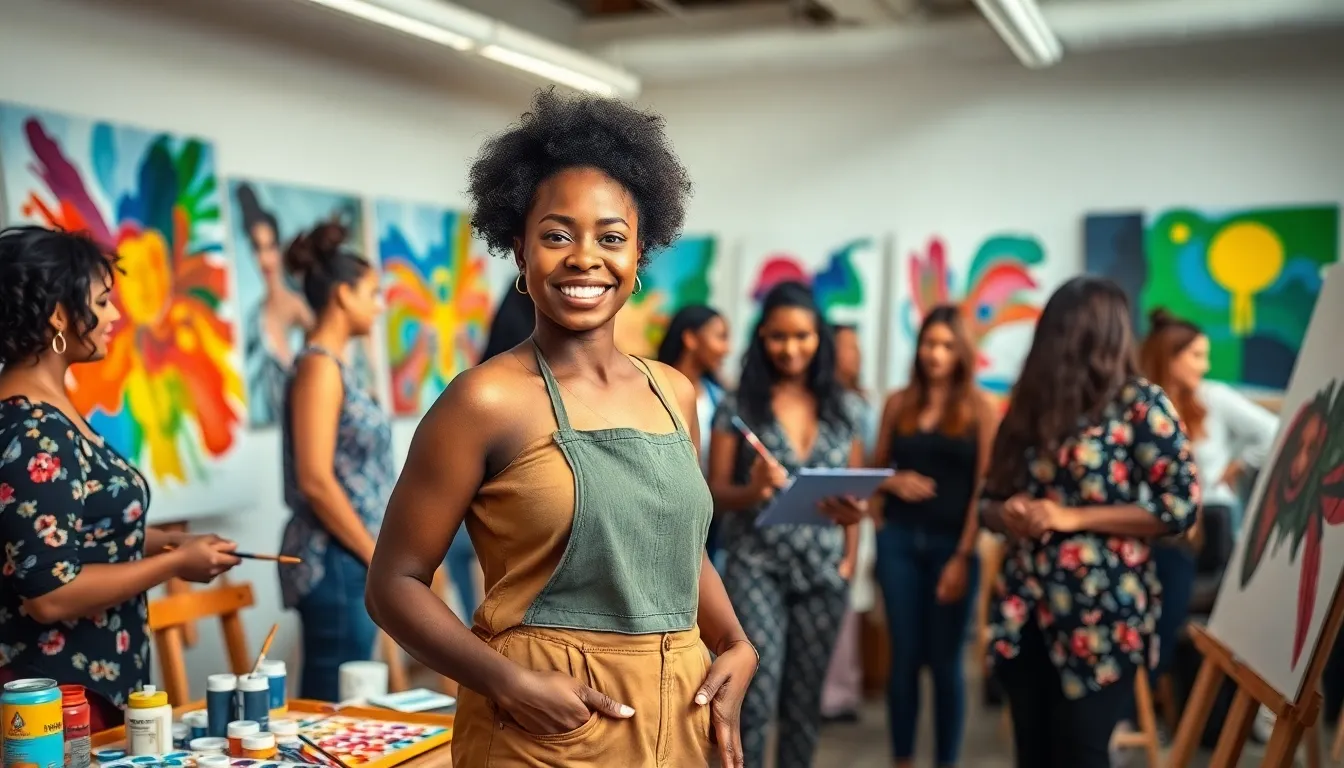Art has long been a canvas for expression, yet the stories of women painters often get overshadowed by their male counterparts. Imagine a world where creativity flows freely, but the names of talented women remain hidden in the shadows. It’s time to shine a spotlight on these remarkable artists who wield their brushes with the same passion and skill as any Picasso or Van Gogh.
Women Painters
Women painters have significantly shaped the art landscape throughout history. Their evolution reflects both individual talent and broader societal changes.
Early Influences and Challenges
Historical barriers often constrained women artists. Limited access to formal training and exhibition opportunities created obstacles. Societal norms dictated that women focus on domestic responsibilities, overshadowing their artistic ambitions. Despite these challenges, early female painters found ways to express their creativity, often working in private spaces. Artists like Sofonisba Anguissola and Artemisia Gentileschi gained recognition in the 16th and 17th centuries. They faced scrutiny but pushed boundaries, demonstrating skill and resilience.
Breakthrough Artists
The 19th and 20th centuries marked pivotal moments for women artists. The emergence of movements such as Impressionism allowed for new expressions. Artists like Mary Cassatt and Berthe Morisot led this charge, showcasing women’s perspectives. Their works gained visibility and challenged conventions, inviting conversations around gender in art. Later, figures like Georgia O’Keeffe and Frida Kahlo reshaped the narrative further. O’Keeffe’s bold abstractions and Kahlo’s intensely personal works explored identity, pushing the art world to reconsider women’s contributions. Recognition grew as these artists inspired generations of female painters.
Notable Women Painters Through History

Women painters have significantly influenced the art world across various eras, pushing artistic boundaries and challenging societal norms.
The Renaissance Era
Sofonisba Anguissola emerged as a prominent figure during the Renaissance, gaining recognition for her portraits that captured emotional depth. Artemisia Gentileschi, another remarkable artist, is celebrated for her dramatic works that often featured strong female protagonists. Both artists navigated a male-dominated landscape, showcasing exceptional talent and defying conventional gender roles. Their contributions laid the groundwork for future generations, proving that women could excel in a field historically reserved for men.
Modern and Contemporary Artists
Mary Cassatt became a leading figure in Impressionism, focusing on intimate depictions of women and children, which provided a unique female perspective. Berthe Morisot, another key Impressionist, blended domestic themes with innovative techniques, enriching the movement. In the 20th century, Georgia O’Keeffe’s large-scale flowers and Southwestern landscapes redefined American art, while Frida Kahlo’s deeply personal paintings explored identity and pain. These artists’ work demonstrates the evolving role of women in art, highlighting individual experiences and cultural narratives.
The Impact of Women Painters on Art Movements
Women painters significantly influenced various art movements, reshaping the landscape with their unique perspectives and creative approaches. Their impact is evident in both feminist art and the diverse representations within the art world.
Feminist Art Movement
The feminist art movement emerged in the late 20th century, driven by women seeking equal recognition in the art world. Artists like Judy Chicago and Miriam Schapiro challenged traditional norms, focusing on women’s experiences and identity. Chicago’s installation, “The Dinner Party,” celebrates influential women throughout history, while Schapiro’s works incorporate domestic materials, transforming them into powerful statements. Their activism not only redefined art practices but also ignited discussions around gender and representation, encouraging new generations of artists to express their identities through their work.
Diverse Representations in Art
Women painters introduced diverse representations that expanded societal perceptions of femininity. Artists such as Amy Sherald and Yayoi Kusama explore themes of race, culture, and identity through their distinct styles. Sherald’s portraits highlight African American experiences, while Kusama’s immersive installations reflect her struggles with mental health and individuality. These artists emphasize the importance of inclusivity in art, challenging stereotypes and inviting viewers to confront their own biases. Their contributions reinforce the idea that art can be a platform for dialogue, reflecting the complexities of human experiences across cultures and backgrounds.
Resources for Aspiring Women Painters
Aspiring women painters can find valuable resources to enhance their skills and build community. Numerous opportunities exist to connect with like-minded individuals and learn from experienced artists.
Workshops and Communities
Local art schools and community centers often host workshops specifically for women. Participants can engage in hands-on activities that enhance both techniques and confidence. Many organizations, like Women’s Caucus for Art, create platforms for women artists to showcase their work and network. Regular meetups facilitate collaboration among artists seeking support and inspiration. Online communities also exist, allowing artists to share their experiences and gain feedback from peers.
Online Platforms and Learning Tools
Numerous online platforms offer courses tailored for aspiring women painters. Websites like Skillshare and Udemy feature classes on various painting techniques and styles. Additionally, resources like YouTube provide free tutorials from experienced artists. Virtual galleries and forums enable artists to present their work, receive critiques, and connect with potential mentors. Art blogs often showcase emerging women artists, inspiring future generations with stories of creativity and resilience.
Conclusion
Recognizing the contributions of women painters is essential for a complete understanding of art history. Their resilience and creativity have shaped the art world in profound ways. From the Renaissance to contemporary movements, these artists have continuously challenged norms and expanded the narrative around femininity and identity.
By highlighting their achievements and providing resources for aspiring artists, society can foster a more inclusive environment that encourages the next generation of women painters. As the art world evolves, it’s crucial to celebrate and support these talented individuals, ensuring their voices and perspectives are heard and valued.

